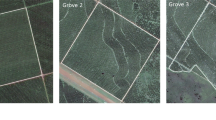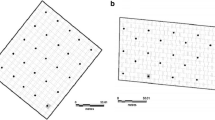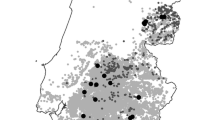Abstract
The productivity of a citrus grove with variation in tree growth was mapped to delineate zones of productivity based on several indicator properties. These properties were fruit yield, ultrasonically measured tree canopy volume, normalized difference vegetation index (NDVI), elevation and apparent electrical conductivity (ECa). The spatial patterns of soil series, soil color and ECa, and their correspondence with the variation in yield emphasized the importance of variation in the soil in differentiating the productivity of the grove. Citrus fruit yield was positively correlated with canopy volume, NDVI and ECa, and yield was negatively correlated with elevation. Although all the properties were strongly correlated with yield and were able to explain the productivity of the grove, citrus tree canopy volume was most strongly correlated (r = 0.85) with yield, explaining 73% of its variation. Tree canopy volume was used to classify the citrus grove into five productivity zones termed as ‘very poor’, ‘poor’, ‘medium’, ‘good’ and ‘very good’ zones. The study showed that productivity of citrus groves can be mapped using various attributes that directly or indirectly affect citrus production. The productivity zones identified could be used successfully to plan soil sampling and characterize soil variation in new fields.








Similar content being viewed by others
References
Abdu, H., Robinson, D. A., & Jones, S. B. (2007). Comparing bulk soil electrical conductivity determination using the DUALEM-1S and EM-38DD EMI instruments. Soil Science Society of America Journal, 71, 189–196.
Boydell, B., & McBratney, A. B. (2002). Identifying potential within-field management zones from cotton-yield estimates. Precision Agriculture, 3, 9–23.
Brouder, S., Hofmann, B., & Morris, D. (2005). Mapping soil pH accuracy of common soil sampling strategies and estimation techniques. Soil Science Society of America Journal, 69, 427–442.
Chien, Y., Lee, D., Guo, H., & Houng, K. (1997). Geostatistical analysis of soil properties of mid-west Taiwan soils. Soil Science, 162, 291–298.
Corwin, D. L., & Lesch, S. M. (2005). Apparent soil electrical conductivity measurements in agriculture. Computers and Electronics in Agriculture, 46, 11–43.
Corwin, D. L., Lesch, S. M., Shouse, P. J., Soppe, R., & Ayars, J. E. (2003). Identifying soil properties that influence cotton yield using soil sampling directed by apparent soil electrical conductivity. Agronomy Journal, 95, 352–364.
Doerge, T. (1999). Management zone concepts. SSMG-2. In Site specific management guidelines. Norcross, GA: Potash and Phosphate Institute. http://ppifarorg/ssmg. Accessed 9 Aug 2010.
Ehsani, R., Schumann, A., & Salyani, M. (2009). Variable rate technology for Florida citrus1. Gainesville: Florida Cooperative Extension Service. AE444. University of Florida, Institute of Food and Agricultural Science. edis.ifas.ufl.edu/document_ae444. Accessed 29 July 2010.
Fleming, K. L., Heermann, D. F., & Westfall, D. G. (2004). Evaluating soil color with farmer input and apparent soil electrical conductivity for management zone delineation. Agronomy Journal, 96, 1581–1587.
Harris, W., Rhue, R., Kidder, G., Brown, R., & Littell, R. (1996). Phosphorus retention as related to morphology of sandy coastal plain soil materials. Soil Science Society of America Journal, 60, 513–1521.
Inman, D., Khosla, R., Reich, R., & Westfall, D. G. (2008). Normalized difference vegetation index and soil color-based management zones in irrigated maize. Agronomy Journal, 100, 60–66.
Johnson, C. K., Eskridge, K. M., Wienhold, B. J., Doran, J. W., Peterson, G. A., & Buchleiter, G. W. (2003). Using electrical conductivity classification and within-field variability to design field-scale research. Agronomy Journal, 95, 602–613.
Jung, W. K., Kitchen, N. R., Sudduth, K. A., Kremer, R. J., & Motavalli, P. P. (2005). Relationship of apparent soil electrical conductivity to claypan soil properties. Soil Science Society of America Journal, 69, 883–892.
Kachanoski, R., De Jong, E., & Wesenbeeck, I. V. (1990). Field scale patterns of soil water storage from non-contacting measurements of bulk electrical conductivity. Canadian Journal of Soil Science, 70, 537–541.
Kerry, R., & Oliver, M. A. (2003). Variograms of ancillary data to aid sampling for soil surveys. Precision Agriculture, 4, 261–278.
Khosla, R., & Alley, M. M. (1999). Soil-specific nitrogen management on mid-Atlantic coastal plain soils (USA). Better Crops, 83, 6–7.
Khosla, R., Fleming, K., Delgado, J. A., Shaver, T. M., & Westfall, D. G. (2002). Use of site-specific management zones to improve nitrogen management for precision agriculture. Journal Soil and Water Conservation (Ankeny), 57, 513–518.
Kitchen, N. R., Sudduth, K. A., Myers, D. B., Drummond, S. T., & Hong, S. Y. (2005). Delineating productivity zones on claypan soil fields using apparent soil electrical conductivity. Computers and Electronics in Agriculture, 46, 285–308.
Land Boundary Information System–Florida Department of Environmental Protection. (2004). Aerial photograph for Florida citrus. data.labins.org/2004/MappingData/DOQQ/. Accessed 19 July 2010.
Muchovej, R. M. (2001). Application of precision agricultural techniques to Florida’s mineral soils. Fla. Coop. Ext. Serv. SS-AGR-172. Gainesville: University of Florida, Institute of Food and Agricultural Sciences. edis.ifas.ufl.edu/AG118. Accessed 9 Aug 2010.
Muchovej, R. M., Hanlon, E. A., Ozores-Hampton, M., Shukla, S., Roka, F. M., Yamataki, H., et al. (2005). Sugarcane production in Southwest Florida: Mineral soils and amendments. Gainesville: Fla. Coop. Ext. Serv. SL 230. University of Florida, Institute of Food and Agricultural Sciences. edis.ifas.ufl.edu/SC073. Accessed 9 Aug 2010.
Muchovej, R. M., Luo, Y., Shine, J., & Jones, J. (2000). Nutritional problems associated with low yield of sugarcane on mineral soils. Soil and Crop Science Society of Florida Proceedings, 59, 146–149.
Mulla, D. J., & Bhatti, A. U. (1997). An evaluation of indicator properties affecting spatial patterns in N and P requirements for winter wheat yield. In J. V. Stafford (Ed.), Precision agriculture ′97 (pp. 145–153). Oxford, UK: BIOS Scientific Publishers.
Mulla, D. J., Bhatti, A. U., Hammond, M. W., & Benson, J. A. (1992). A comparison of winter wheat yield and quality under uniform versus spatially variable fertilizer management. Agriculture, Ecosystems and Environment, 38, 301–311.
Obreza, T. A., Zekri, M., & Hanlon, E. W. (2008a). Soil and leaf tissue testing. In T. A. Obreza & K. L. Morgan (Eds.), Nutrition of Florida citrus trees (2nd ed., pp. 24–32). Gainesville: Florida Cooperative Extension Service. SL253. University of Florida, Institute of Food and Agricultural Sciences. edis.ifas.ufl.edu/SS478. Accessed 9 Aug 2010.
Obreza, T. A., Zekri, M., & Stephen., H. F. (2008b). General soil fertility and citrus tree nutrition. In T. A. Obreza & K. L. Morgan (Eds.), Nutrition of Florida citrus trees (2nd ed., pp. 16–22). Gainesville: Florida Cooperative Extension Service SL253. University of Florida, Institute of Food and Agricultural Sciences. edis.ifas.ufl.edu/SS478. Accessed 19 July 2010.
Official Soil Series Descriptions (OSD). (1999). With series extent mapping capabilities. USDA. NRCS. http://soils.usda.gov/technical/classification/osd. Accessed 29 July 2010.
Ovalles, F. A., & Collins, M. E. (1986). Soil-landscape relationships and soil variability in north central Florida. Soil Science Society of America Journal, 50, 401–408.
Ping, J., Green, C., Bronson, K., Zartman, R., & Dobermann, A. (2005). Delineating potential management zones for cotton based on yields and soil properties. Soil Science, 170, 371.
Sanchez-Maranon, M., Ortega, R., Miralles, I., & Soriano, M. (2007). Estimating the mass wetness of Spanish and soils from lightness measurements. Geoderma, 141, 397–406.
Schueller, J. K., Whitney, J., Wheaton, T., Miller, W., & Turner, A. (1999). Low-cost automatic yield mapping in hand-harvested citrus. Computers and Electronics in Agriculture, 23, 145–153.
Schumann, A. W., Fares, A., Alva, A. K., & Paramasivam, S. (2003). Response of ‘Hamlin’ orange to fertilizer source, rate and irrigated area. Proceedings of Florida State Horticultural Society, 116, 256–260.
Schumann, A. W., Hostler, K. H., Miller, W. M., & Zaman, Q. (2004). Sensor-based automatic yield monitoring for manually harvested citrus. Pap. 041098. St. Joseph, MI: ASAE.
Schumann, A. W., & Zaman, Q. (2003). Mapping water table depth by electromagnetic induction. Applied Engineering in Agriculture, 19, 675–688.
Schumann, A. W., & Zaman, Q. (2005). Software development for real-time ultrasonic mapping of tree canopy size. Computers and Electronics in Agriculture, 47, 25–40.
Statistical Analysis System Institute. (2003). SAS/STAT Guide for personal computers. Version 9.1. Cary, NC: SAS Institute Incorporation.
Wheaton, T. A., Whitney, J. D., Castle, W. S., Muraro, R. P., Browning, H. W., & Tucker, D. P. H. (1995). Citrus scion and rootstock, topping height, and tree spacing affect tree size, yield, fruit quality, and economic return. Journal of the American Society for Horticultural Science, 120, 861–870.
Whitney, J. D., Miller, W. M., Wheaton, T. A., Salyani, M., & Schueller, J. K. (1999). Precision farming applications in Florida citrus. Applied Engineering in Agriculture, 15, 399–403.
Wibawa, W., Dludlu, D., Swenson, L. J., Hopkins, D., & Dahnke, W. (1993). Variable fertilizer application based on yield goal, soil fertility, and soil map unit. Journal of Production Agriculture, 6, 255–261.
Ye, X., Sakai, K., Asada, S., & Sasao, A. (2008). Application of narrow-band TBVI in estimating fruit yield in citrus. Biosystems Engineering, 99, 179–189.
Zaman, Q., & Schumann, A. W. (2005). Performance of an ultrasonic tree volume measurement system in commercial citrus groves. Precision Agriculture, 6, 467–480.
Zaman, Q., & Schumann, A. W. (2006). Nutrient management zones for citrus based on variation in soil properties and tree performance. Precision Agriculture, 7, 45–63.
Zaman, Q., Schumann, A. W., & Hostler, H. K. (2006). Rapid estimation of citrus tree damage from hurricanes in Florida using an ultrasonic tree measurement system. HortTechnology, 16, 339–344.
Zaman, Q., Schumann, A. W., & Miller, W. M. (2005). Variable rate nitrogen application in Florida citrus based on ultrasonically-sensed tree size. Applied Engineering in Agriculture, 21, 331–335.
Acknowledgments
This research was supported by the Florida Agricultural Experiment Station and the Hunt Brothers graduate fellowship. The authors would like to thank Mosaic Co. for the use of their grove, Kevin Hostler, Reza Ehsani, Sherrie Buchanan, and other staff members of the CREC and SWS departments who assisted in this study. Mention of trade names and commercial products is solely for the purpose of providing specific information and does not imply recommendation by the University of Florida or its cooperators.
Author information
Authors and Affiliations
Corresponding author
Rights and permissions
About this article
Cite this article
Mann, K.K., Schumann, A.W. & Obreza, T.A. Delineating productivity zones in a citrus grove using citrus production, tree growth and temporally stable soil data. Precision Agric 12, 457–472 (2011). https://doi.org/10.1007/s11119-010-9189-y
Published:
Issue Date:
DOI: https://doi.org/10.1007/s11119-010-9189-y




